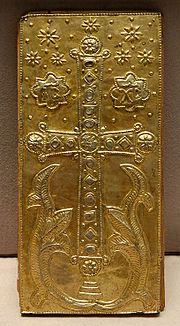
Relics of Sainte-Chapelle
Encyclopedia


Relic
In religion, a relic is a part of the body of a saint or a venerated person, or else another type of ancient religious object, carefully preserved for purposes of veneration or as a tangible memorial...
s of Jesus Christ acquired by the French monarchy in the Middle Ages and now conserved by the Archdiocese of Paris. They were originally housed at Sainte-Chapelle
Sainte-Chapelle
La Sainte-Chapelle is the only surviving building of the Capetian royal palace on the Île de la Cité in the heart of Paris, France. It was commissioned by King Louis IX of France to house his collection of Passion Relics, including the Crown of Thorns - one of the most important relics in medieval...
in Paris
Paris
Paris is the capital and largest city in France, situated on the river Seine, in northern France, at the heart of the Île-de-France region...
and are now in the cathedral treasury of Notre Dame de Paris
Notre Dame de Paris
Notre Dame de Paris , also known as Notre Dame Cathedral, is a Gothic, Roman Catholic cathedral on the eastern half of the Île de la Cité in the fourth arrondissement of Paris, France. It is the cathedral of the Catholic Archdiocese of Paris: that is, it is the church that contains the cathedra of...
.
Medieval and early modern
Saint LouisLouis IX of France
Louis IX , commonly Saint Louis, was King of France from 1226 until his death. He was also styled Louis II, Count of Artois from 1226 to 1237. Born at Poissy, near Paris, he was an eighth-generation descendant of Hugh Capet, and thus a member of the House of Capet, and the son of Louis VIII and...
built Sainte-Chapelle to house the Holy Crown
Crown of Thorns
In Christianity, the Crown of Thorns, one of the instruments of the Passion, was woven of thorn branches and placed on Jesus Christ before his crucifixion...
, a fragment of the True Cross
True Cross
The True Cross is the name for physical remnants which, by a Christian tradition, are believed to be from the cross upon which Jesus was crucified.According to post-Nicene historians, Socrates Scholasticus and others, the Empress Helena The True Cross is the name for physical remnants which, by a...
and other relics he had acquired from Baldwin II of Constantinople
Baldwin II of Constantinople
Baldwin II of Courtenay was the last emperor of the Latin Empire of Constantinople.He was a younger son of Yolanda of Flanders, sister of the first two emperors, Baldwin I and Henry of Flanders...
. This made the chapel itself an immense reliquary, housing the crown, the True Cross fragment, relics of the Virgin Mary, the Holy Lance
Holy Lance
The Holy Lance is the name given to the lance that pierced Jesus' side as he hung on the cross in John's account of the Crucifixion.-Biblical references:The lance is mentioned only in the Gospel of John and not in any of the...
, the Holy Sponge
Holy Sponge
The Holy Sponge is one of the Instruments of the Passion of Jesus Christ. It was dipped in vinegar and offered to Christ to drink during the Crucifixion, according to Matthew 27:48; Mark 15:36; and John 19:29...
and the Mandylion
Image of Edessa
According to Christian legend, the Image of Edessa was a holy relic consisting of a square or rectangle of cloth upon which a miraculous image of the face of Jesus was imprinted — the first icon ....
, a supposed image of Christ In the early modern era the kings of France drained their treasury, sold rubies and melted down gold to supply their vast military spending needs, making all the chapel's ecclesiastical treasures into a monetary reserve that could be used if needed, as they had also been in the medieval era. This meant that under Henry IV of France
Henry IV of France
Henry IV , Henri-Quatre, was King of France from 1589 to 1610 and King of Navarre from 1572 to 1610. He was the first monarch of the Bourbon branch of the Capetian dynasty in France....
what was left of the treasure was reduced to the state it would hold until the French Revolution
French Revolution
The French Revolution , sometimes distinguished as the 'Great French Revolution' , was a period of radical social and political upheaval in France and Europe. The absolute monarchy that had ruled France for centuries collapsed in three years...
.
Revolution to present
The Revolution meant a ban on conserving relics and all other sacred symbols links to the kings, though this allowed for pieces judged to be of high artistic quality to be saved. These relics were handed over to the archbishop of Paris in 1804 and are still held in the cathedral treasury of Notre Dame, cared for by the Knights of the Holy SepulchreOrder of the Holy Sepulchre
The Equestrian Order of the Holy Sepulchre of Jerusalem is a Roman Catholic order of knighthood under the protection of the pope. It traces its roots to Duke Godfrey of Bouillon, principal leader of the First Crusade...
and the cathedral chapter. Every first Wednesday of the month, in the afternoon, guarded by the Knights, the Holy Relics are exposed for veneration and adoration by the faithful before the cathedral's high altar. Every Good Friday, this adoration lasts all day, punctuated by the liturgical offices. An exhibition entitled Le trésor de la Sainte-Chapelle was put on at the Louvre
Louvre
The Musée du Louvre – in English, the Louvre Museum or simply the Louvre – is one of the world's largest museums, the most visited art museum in the world and a historic monument. A central landmark of Paris, it is located on the Right Bank of the Seine in the 1st arrondissement...
in 2001.

